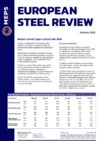Why beams prices defied September’s steel price decline
Medium sections and beams prices bucked the European steel market’s downward price trend on the back of reduced production and an uptick in export activity, MEPS research revealed.
Insight published in the September edition of MEPS's European Steel Review, showed that the vast majority of transaction prices – across flat and long products – were either the same or lower than in August. Expectations of a post-holiday market recovery failed to materialise.
Medium sections and beams bucked the general trend, however. With the exception of the United Kingdom, prices increased in all of the Western European countries surveyed.
The upward price trend for beams has surprised many market participants. This is because sales tend to go into similar end-user industries, such as the construction industry.
Supply is the key factor influencing prices. The availability of beams, from European sources, is limited for the fourth quarter of the year. There are shortages for common sizes and grades, and stocks at both mill and distributor level are declining.
Reason for beams’ price resilience
Unlike many other steel products, the regional production of H and I beams is concentrated among a small number of manufacturers. Almost without exception, these businesses paused production for between two and four weeks during the traditional summer holiday period, citing a need for scheduled mill maintenance. Consequently, European beam mills have been limiting the volume of material they make available to regional consumers.
ArcelorMittal’s sales have been boosted by increased export sales to North America. MEPS understands that significant quantities of European-origin beams have been sold to the United States and Canada. Enticed by the comparatively higher prices on offer in North America, European beams producers sought to maximise their sales ahead of the closing of the Great Lakes navigation.
According to MEPS’s research respondents, German producer Stahlwerk Thüringen has, similarly, increased its exports, limiting the supply it allocates to domestic customers.
A temporary closure at ArcelorMittal’s Luxembourg site – the result of an accident – has also extended mill delivery lead times. In the UK, British Steel’s capacity is reduced due to ongoing blast furnace issues. Meanwhile, the ramp-up of Duferco’s new San Zemo facility, in Italy, has been slower than expected. MEPS respondents also claim that Celsa Group – under its new owners – is reluctant to commit to spot deals. This suggests that it has a stronger-than-expected short-term order book.
Recent price trend may not persist
Either side of the traditional holiday period, steel manufacturers signalled their intention to raise their price quotations. Unlike flat and other long products, the pricing measures imposed by beam mills did garner a level of market support. This was despite weak demand fundamentals.
Several MEPS research partners – trading in all steel products – said that they expect the October to December period to be a “fight for survival” as weak demand and downward price pressure persists. Unless regional supply continues to be restricted, beam mills will find it difficult to maintain their recent price gains.

Source:
European Steel Review
The MEPS European Steel Review is an informative, concise and easy-to-use monthly publication, offering unique professional insight into European carbon steel prices.
Go to productRequest a free publication





